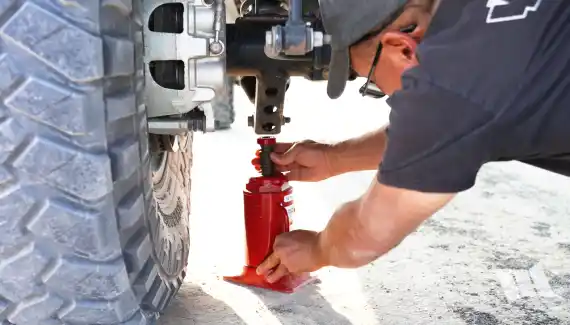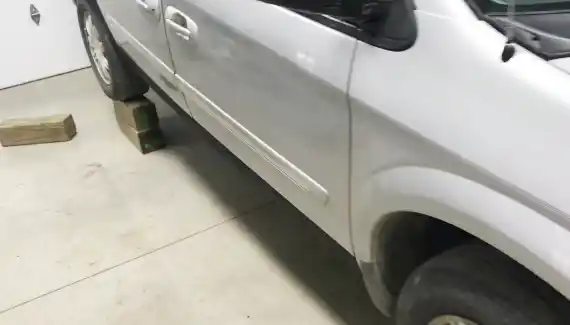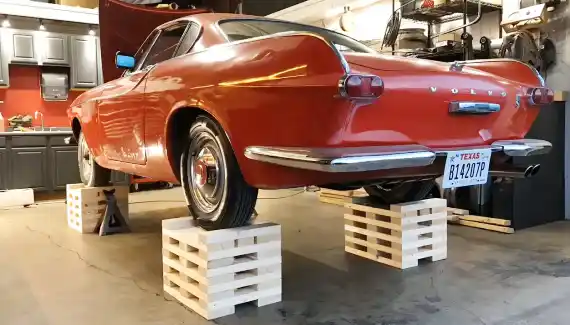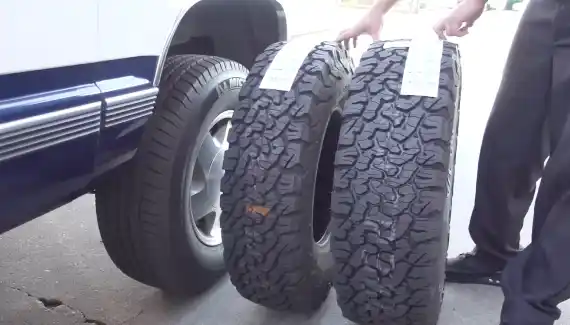Last Updated on June 13, 2023
Are you looking to lift your truck without breaking the bank? Believe it or not, there are plenty of ways to do so without a costly and time-consuming lift kit installation.
Whether you want to increase ground clearance for added off-roading fun or simply prefer the look of your ride higher off the pavement, lifting a truck doesn’t have to be an expensive undertaking.
We will discuss how to lift a truck without a lift kit properly. We will also cover the risks associated with this type of modification and provide some tips on how to ensure that your DIY project runs smoothly. Read on for more information about lifting a truck without a lift kit.
Can You Lift A Truck Without A Lift Kit: Reasons

Reason 1. Off-Road Capabilities
Lifting a truck increases ground clearance and enables it to handle rough terrain. It can improve the approach and departure angles on slopes, meaning less risk of getting stuck in off-road environments.
This lift also provides increased room for large tires better suited for off-roading, such as mud tires or rock-crawling tires. Larger wheels create a firmer grip on uneven surfaces like sand and gravel, helping to give enhanced vehicle control when going over obstacles.
Reason 2. Aesthetics
Raising a truck can give it an eye-catching look, making it stand out from the crowd. With some modifications, it is possible to add further customization by changing the overall appearance with options like fender flares or body lift kits.
Lifting a truck is also beneficial if you add running boards or larger bumpers since there will be greater clearance space between them and the ground.
Reason 3. Performance
Raising a truck improves handling and stability when driving at higher speeds or taking sharp turns. This is mainly due to its center of gravity, raised when lifting the truck, resulting in improved weight distribution throughout the vehicle’s suspension system.
This helps with traction control when cornering and shorter brake distances in emergencies due to increased downforce at higher speeds.
Reason 4: Utility
Lifting a truck creates more space underneath for aftermarket modifications such as exhaust pipes, hitch mounts, skid plates, or fuel tanks while still offering sufficient ground clearance to prevent scraping your undercarriage on bumps and obstacles encountered while driving off-road.
Larger tires can also be used, which offer more resistance against punctures. Plus, they reduce wear on components like brakes and shock absorbers by absorbing impacts from potholes and other road hazards encountered daily driving in urban areas.
Materials Needed

Jack
A jack is necessary for lifting a truck off without a lift kit because it provides the mechanical force needed to raise the vehicle. This tool is typically operated by a hand crank or lever, which raises a piston and generates an upward force.
To ensure safety, use the correct type of jack, such as a low-profile jack, when attempting to lift a truck without a lift kit.
Jack Stands
Jack stands to provide stability and support for trucks that are lifted with a jack. Without them, the truck’s weight could cause the jack to fail or collapse, potentially leading to severe injury or property damage. Jack stands are typically adjustable and provide adequate support while working on them.
Cinder Blocks
Cinder blocks are another option for supporting lifted trucks without using a lift kit. These blocks can be used in addition to adjustable jack stands for increased stability and safety.
Cinder blocks should be placed securely under each side of the vehicle to distribute weight evenly and prevent tipping over during repairs or maintenance.
Woodblocks
Woodblocks can also be used in place of jacks and jack stands when lifting trucks without a lift kit. These blocks provide support while also allowing some height adjustment.
They should be placed under each side of the trucks at an equal distance from each other for optimal stability and safety while working on the truck.
Impact Wrench
An impact wrench is essential when removing nuts and bolts from a lifted truck without a lift kit. This tool ensures that they can be quickly and easily removed without using manual tools like spanners or ratchets, which require more physical effort.
Impact wrenches should be used with caution to ensure that it does not apply too much pressure, which could potentially damage fasteners or components beneath them due to excessive torque.
Preparing the Truck
Park the Truck on Level Ground

Ensure that it is on a flat and even surface that won’t shift or move unexpectedly. Check the surrounding area for hazards like large rocks, branches, or other debris that could impede your progress.
Place Jack Stands Under The Truck
One stand on each side of the frame for extra support and safety. You will also want to place a heavy-duty jack under the vehicle before lifting it to ensure that it’s adequately supported as you’re working on it. Check your owner’s manual for the proper placement of these devices before continuing.
Remove Any Obstacles Around The Truck
Include any items stored in its bed or cab which could interfere with your work. This will also help minimize any potential risks associated with lifting such a large vehicle without a lift kit, as well as eliminate distractions from materials that don’t need to be there while you are focusing on this task at hand.
Apply The Emergency Brake
Once everything is clear, you are ready to start lifting the truck off of its wheels. This is an essential step, as having the emergency brake engaged will help keep your vehicle safely in place while you are working underneath it and help prevent it from shifting or moving during this process.
Lifting the Truck
Place The Jack Under The Specific Lift Point
The first step in lifting a truck without any lift kit is to position the jack under the designated lift point. It is important to find the correct lift points, typically located close to the axle on each side of the truck.
Once these points have been identified, you can use either a bottle jack or a trolley jack to lift the truck. Place your jack at an angle that allows it to support the truck’s weight, and make sure it is firmly in place before continuing.
Lift the Truck Using the Jack Until the Tire is Off the Ground
Once the lift point has been identified and located, you can begin lifting the truck with the jack. Start by turning it manually until it lifts slightly off the ground, making sure not to over-tighten it as this could cause damage to both the jack and vehicle structure.
Continue smoothly increasing pressure until you reach an angle that allows you to fit your cinder blocks or wooden blocks underneath the tire for added support and stability before continuing further.
Place Cinder Blocks Or Wood Blocks Under The Tire For Added Stability

Now that your truck is suspended in mid-air with enough space for an adequate work area beneath its wheels, you will need to loosen any lug nuts using an impact wrench before proceeding further with any suspension modifications or maintenance tasks required.
Ensure that all nuts are adequately loosened so as not to cause any unnecessary stress on them during your work process. Otherwise, you may run into issues when attempting to replace them later on down the line.
Loosen The Lug Nuts Using The Impact Wrench
After securing them in place, loosen each lug nut using an impact wrench to make it easier to remove them completely later on when swapping out tires or changing brakes.
Ensure that each lug nut is loosened before attempting to adjust suspension components or balance your wheels. Failure to do so could result in serious injury or damage due to sudden mechanical motion while working on the vehicle.
Adjust The Suspension Components
You can now adjust various suspension components such as shock absorbers, struts, springs, and sway bars while working on a lifted truck that doesn’t have a lift kit.
With these parts in good condition after being properly tightened and lubricated, you can be sure that your vehicle will remain safe and stable for driving after completing all necessary repairs or modifications made while lifting it without a kit specific for doing so.
Balance The Truck
Once all the suspension components have been fitted correctly, it is essential to balance the truck to ensure optimal performance. Users can achieve optimal handling performance by precisely adjusting and readjusting the weight distribution across the four wheels.
Per the manufacturer’s recommendations for each tire size, as detailed in the user manual, this must be done. It is critical to ensure that all tires have an equal weight load to maximize tire grip.
This allows for less impact on individual tires when driving safely over uneven terrain and potholes at higher speeds over long distances.
Lowering the Truck
Remove The Cinder Blocks Or Wood Blocks

Remove the wood blocks or cinder blocks you have placed under your truck to lift them. Carefully remove them one at a time and store them in a safe place. To prevent damage, slide each block out slowly rather than lifting it abruptly.
Lower The Truck Using The Jack
Use a jack to lower the truck down from its elevated position and make sure the jack is centered under the vehicle. With steady hands, adjust the crank to decrease the height of your truck, making it lower until it reaches the ground level.
Place a piece of cardboard underneath so there is no direct contact between the jack and the ground surface.
Replace The Lug Nuts And Tighten Them
Once lowered, replace all lug nuts so that they are appropriately secure and in proper alignment with one another for optimal performance and safety assurance. Ensure that all lug nuts are tightened with enough force to stay in place without coming loose when driving over bumps or rough terrain.
Lower The Truck Completely Back Onto The Ground
Finally, completely lower your truck back onto the ground by adjusting the crank on your jack until your vehicle has returned to its original position before lifting it off with cinder blocks or wood blocks earlier on.
When reading this step, be aware that if you do not lower it enough, you will risk damaging parts of your car when driving over potholes or other obstacles around town.
Is a Truck Lifting Without a Lift Kit Safe?
Lifting a truck devoid of a lift kit is relatively safe, given that all precautions are taken. Ensure that the truck is securely jacked up and stabilized before any work begins to reduce any potential for accidental damage or injury.
Truck owners should always use extreme caution when maneuvering underneath any vehicle, as there will be added stress on the chassis due to the lack of suspension support from a lift kit. This is an easy way to modify your truck while being mindful of safety considerations.
Can I Put Bigger Tires on My Truck Without a Lift?

You can put bigger tires on your truck without a lift. Depending on your truck’s size and suspension capabilities, you may be able to fit up to 33” tires without needing a lift kit. Larger tire sizes require additional modifications, such as wheel spacers or longer wheel studs.
But these can be done without modifying the suspension or lifting the vehicle. A lift kit increases your truck’s center of gravity, leading to reduced ground clearance and handling performance. To ensure your tires meet safety requirements, check the manufacturer’s specifications for the maximum tire size and load rating.
Achieve The Look of a Lifted Truck Without an Aftermarket Lift Kit
Without a lift kit, you can lift a truck with the proper knowledge and tools. It requires some mechanical know-how and dedication to your project, but the satisfaction of seeing your lifted truck cruising down the road is worth it.
You can still get that high-than-normal stance without an aftermarket lift kit if you have the skill and patience. When lifting without a kit, remember that any modifications you make should be done under the manufacturer’s guidelines to ensure your safety.
Check the frame and body of your vehicle before attaching any components or hardware so that everything is structurally sound. If you take your time and research, there’s no reason you can’t enjoy the same benefits as those who install aftermarket kits, all without breaking the bank.
